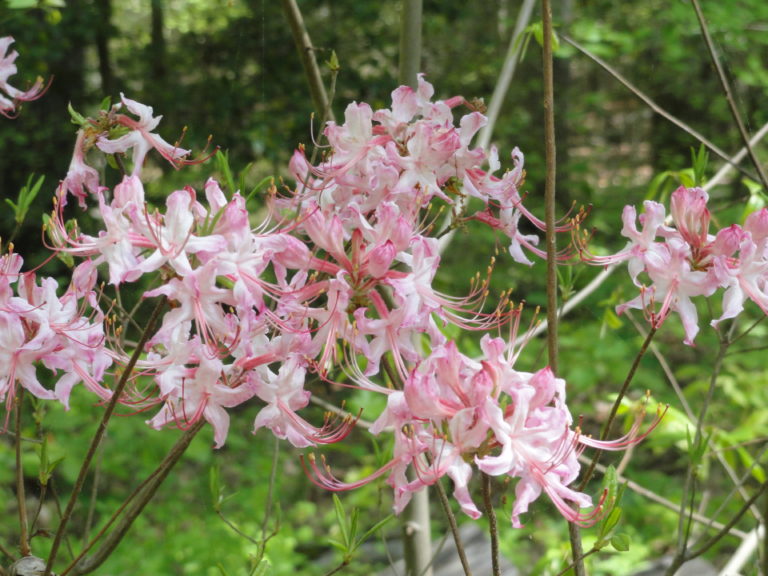The Pinxter Azalea is a deciduous native azalea famous for it’s stunning flowers all the way from New Hampshire to Alabama. In NC, it is present in most counties of the state except for the highest mountain counties and the swampiest counties in the northeast corner. Pinxter Azalea’s funnel-shaped flowers, with elegantly long exserted stamens, occur in large terminal clusters ranging from white to all shades of pink. Flowers start to open before leaf expansion, drawing many pollinators, including hummingbirds, bees, and butterflies. Pinxter is very hardy, tolerating most soil types as long as they are organic, well drained and acidic, and it thrives in dappled sun or partial shade or even in bright, indirect light. It lights up a woodland garden!
NURSERY HOURS
Wednesday: 10-4 Thursday: 10-6 Friday-Saturday: 10-4 Sunday: 12-4
Rhododendron periclymenoides (synonym R. nudiflorum)

Key Info
Scientific Name: Rhododendron periclymenoides (Michx.) Shinners
Common Names: Pinxterbloom Azalea, Pinxterflower, Pink Azalea
Family Names: Ericaceae (Heath Family)
Plant Type: Tree / Shrub
Leaf Retention: Deciduous
Flower Color: Shades of pink
Special Characteristics: Flowers fragrant, Attracts bees, Attracts butterflies, Attracts Hummingbirds
Additional Info
Habit: Medium-textured, spreading or rounded, non-stoloniferous shrub with many upright stems and horizontal branches. Its bark is shreddy, gray to reddish-brown, and its root system shallow and fibrous.
Height: 6' to 10' usually 6'
Spread: 6' to 8'
Soil Conditions: Acidic, humusy, moisture-retentive but well-drained soils; tolerates dryish, sandy or rocky soils.
Leaves: Alternate, appearing whorled at branch tips; simple, with smooth or toothed margins, elliptic to oblong 1½. to 4" x ½ to 1¼ ", medium green, turn dull yellow in fall.
Flowers (or reproductive structures: Inflorescences are 6-15 flowered, terminal clusters of vase- or funnel-shaped flowers, tube longer than lobes, in shades of pink, rarely white, tube often deeper colored. The flowers are sometimes fragrant, occurring before or durring leaf expansion. They are up to 1½” across, with 5 petal lobes and 5 long curved stamens (sometimes twice the length of the corolla). R. periclymenoides can be distinguished from R. canescens by its flower tubes which are typically fuzzy or pubescent but do not have sticky glandular hairs on the back.
Fruit: Many seeds in small, oval, brown pods, mature in fall.
Natural Distribution: Moist woods, swamp margins and open areas.
USDA Hardiness Zone: 4 to 9
USDA Wetland Indicator Status in NC: FAC
Pollination: Butterflies, hummingbirds, bees and other insects.
Wildlife Connections: Attracts birds, large numbers of bumble bees and other bees, hummingbirds and butterflies. Is not immune to deer browse.
Propagation: Propagated from seed, root cuttings or stem cuttings..
